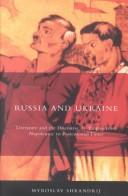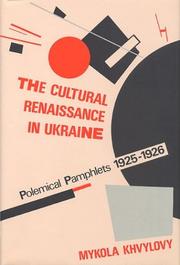| Listing 1 - 9 of 9 |
Sort by
|

ISBN: 1282859501 9786612859502 0773569499 9780773569492 0773522344 9780773522343 9781282859500 6612859504 Year: 2001 Publisher: Montreal : McGill-Queen's university press,
Abstract | Keywords | Export | Availability | Bookmark
 Loading...
Loading...Choose an application
- Reference Manager
- EndNote
- RefWorks (Direct export to RefWorks)
Concepts of civilizational superiority and redemptive assimilation, widely held among nineteenth-century Russian intellectuals, helped to form stereotypes of Ukraine and Ukrainians in travel writings, textbooks, and historical fiction, stereotypes that have been reactivated in ensuing decades. Both Russian and Ukrainian writers have explored the politics of identity in the post-Soviet period, but while the canon of Russian imperial thought is well known, the tradition of resistance B which in the Ukrainian case can be traced as far back as the meeting of the Russian and Ukrainian polities and cultures of the seventeenth century B is much less familiar. Shkandrij demonstrates that Ukrainian literature has been marginalized in the interests of converting readers to imperial and assimilatory designs by emphasizing narratives of reunion and brotherhood and denying alterity.
Russian literature --- Ukrainian literature --- Imperialism in literature. --- History and criticism. --- Imperialism in literature --- History and criticism --- E-books
Book
ISBN: 1282353004 9786612353000 0300156251 9780300156256 0300125887 9780300125887 9780300125887 9781282353008 Year: 2009 Publisher: New Haven Yale University Press
Abstract | Keywords | Export | Availability | Bookmark
 Loading...
Loading...Choose an application
- Reference Manager
- EndNote
- RefWorks (Direct export to RefWorks)
This pioneering study is the first to show how Jews have been seen through modern Ukrainian literature. Myroslav Shkandrij uses evidence found within that literature to challenge the established view that the Ukrainian and Jewish communities were antagonistic toward one another and interacted only when compelled to do so by economic necessity. Jews in Ukrainian Literature synthesizes recent research in the West and in the Ukraine, where access to Soviet-era literature has become possible only in the recent, post-independence period. Many of the works discussed are either little-known or unknown in the West. By demonstrating how Ukrainians have imagined their historical encounters with Jews in different ways over the decades, this account also shows how the Jewish presence has contributed to the acceptance of cultural diversity within contemporary Ukraine.
Jews in literature. --- Ukrainian literature --- History and criticism.
Book
ISBN: 1618119761 9781618119766 9781618119759 1618119753 Year: 2019 Publisher: Boston, MA
Abstract | Keywords | Export | Availability | Bookmark
 Loading...
Loading...Choose an application
- Reference Manager
- EndNote
- RefWorks (Direct export to RefWorks)
Many of the greatest avant-garde artists of the early twentieth century were Ukrainians or came from Ukraine. Whether living in Paris, St. Petersburg or Kyiv, they made major contributions to painting, sculpture, theatre, and film-making. Because their connection to Ukraine has seldom been explored, English-language readers are often unaware that figures such as Archipenko, Burliuk, Malevich, and Exter were inspired both by their country of origin and their links to compatriots. This book traces the avant-garde development from its pre-war years in Paris to the end of the 1920's in Kyiv. It includes chapters on the political dilemmas faced by this generation, the contribution of Jewish artists, and the work of several emblematic figures: Mykhailo Boichuk, David Burliuk, Kazimir Malevich, Vadym Meller, Ivan Kavaleridze, and Dziga Vertov.
Art, Ukrainian --- Avant-garde (Aesthetics) --- Aesthetics --- Modernism (Art) --- History --- 20th century art. --- Avant Garde. --- Boichuk School. --- Boichuk. --- Burliuk. --- David Burliuk. --- Dziga Vertov. --- French avant garde. --- French avant-garde. --- Ivan Kavaleridze. --- Jewish artists. --- Jewish. --- Jews. --- Kazimir Malevich. --- Malevich. --- Soviet Union Art. --- Soviet Union. --- Ukraine. --- Ukrainian art. --- Ukrainian culture. --- Ukrainian history. --- Ukrainian politics. --- Ukrainian. --- Vadym Meller. --- Vertov. --- art. --- avant-garde. --- cultural memory. --- culture. --- history. --- politics. --- revolution. --- twentieth century art. --- twentieth-century art. --- Art, Ukrainian. --- Avant-garde (Aesthetics). --- 1900-1999.

ISBN: 0920862861 Year: 1992 Publisher: Edmonton : Canadian institute of Ukrainian studies press, University of Alberta,
Abstract | Keywords | Export | Availability | Bookmark
 Loading...
Loading...Choose an application
- Reference Manager
- EndNote
- RefWorks (Direct export to RefWorks)
Book
ISBN: 9780367375577 0429319487 9781000134841 1000134849 9781000139983 1000139980 9781000145120 1000145123 Year: 2019 Publisher: New York Routledge
Abstract | Keywords | Export | Availability | Bookmark
 Loading...
Loading...Choose an application
- Reference Manager
- EndNote
- RefWorks (Direct export to RefWorks)
This book examines four dramatic periods that have shaped not only Ukrainian, but also Soviet and Russian history over the last hundred years: the revolutionary struggles of 1917-20, Stalin's "second" revolution of 1928-33, the mobilization of revolutionary nationalists during the Second World War, and the Euromaidan protests of 2013-14. The story is told from the perspective of "insiders." It recovers the voice of Bolshevik historians who first described the 1917-21 revolution in Ukraine; citizens who were accused of nationalist conspiracies by Stalin; Galician newspapers that covered the 1933-34 famine; nationalists who fomented revolution in the 1940s; and participants in the Euromaidan protests and Revolution of 2013-14. In each case the narrative reflects current "memory wars" over these key moments in history. The discussion of these flashpoints in history in a balanced, insightful and illuminating. It introduces recent research findings and new archival materials, and provides a guide to the heated controversies that have today focused attention scholarly and public attention on the issues of nationalism and Russian-Ukrainian relations. The Euromaidan protesters declared that "Ukraine is not Russia," but the slogan was already current in 1917. This volume describes the process that led to its reappearance in the present day "This book examines four dramatic periods that have shaped not only Ukrainian, but also Soviet and Russian history over the last hundred years: the revolutionary struggles of 1917-20, Stalin's "second" revolution of 1928-33, the mobilization of revolutionary nationalists during the Second World War, and the Euromaidan protests of 2013-14. The story is told from the perspective of "insiders." It recovers the voice of Bolshevik historians who first described the 1917-21 revolution in Ukraine; citizens who were accused of nationalist conspiracies by Stalin; Galician newspapers that covered the 1933-34 famine; nationalists who fomented revolution in the 1940s; and participants in the Euromaidan protests and Revolution of 2013-14. In each case the narrative reflects current "memory wars" over these key moments in history. The discussion of these flashpoints in history in a balanced, insightful and illuminating. It introduces recent research findings and new archival materials, and provides a guide to the heated controversies that have today focused attention scholarly and public attention on the issues of nationalism and Russian-Ukrainian relations. The Euromaidan protesters declared that "Ukraine is not Russia," but the slogan was already current in 1917. This volume describes the process that led to its reappearance in the present day."--
Revolutions --- Nationalism --- Memory --- History --- Ukraine --- Russia (Federation) --- Relations
Multi
ISBN: 9781618119766 9781618119759 1618119753 1618119761 1644696274 Year: 2019 Publisher: Boston, Mass. Academic Studies Press
Abstract | Keywords | Export | Availability | Bookmark
 Loading...
Loading...Choose an application
- Reference Manager
- EndNote
- RefWorks (Direct export to RefWorks)
Many of the greatest avant-garde artists of the early twentieth century were Ukrainians or came from Ukraine. Whether living in Paris, St. Petersburg or Kyiv, they made major contributions to painting, sculpture, theatre, and film-making. Because their connection to Ukraine has seldom been explored, English-language readers are often unaware that figures such as Archipenko, Burliuk, Malevich, and Exter were inspired both by their country of origin and their links to compatriots. This book traces the avant-garde development from its pre-war years in Paris to the end of the 1920's in Kyiv. It includes chapters on the political dilemmas faced by this generation, the contribution of Jewish artists, and the work of several emblematic figures: Mykhailo Boichuk, David Burliuk, Kazimir Malevich, Vadym Meller, Ivan Kavaleridze, and Dziga Vertov.
Art --- Art, Ukrainian --- Art, Ukrainian. --- Avant-garde (Aesthetics) --- Avant-garde (Aesthetics). --- History --- 1900-1999. --- Ukraine. --- 20th century art. --- Avant Garde. --- Boichuk School. --- Boichuk. --- Burliuk. --- David Burliuk. --- Dziga Vertov. --- French avant garde. --- French avant-garde. --- Ivan Kavaleridze. --- Jewish artists. --- Jewish. --- Jews. --- Kazimir Malevich. --- Malevich. --- Soviet Union Art. --- Soviet Union. --- Ukrainian art. --- Ukrainian culture. --- Ukrainian history. --- Ukrainian politics. --- Ukrainian. --- Vadym Meller. --- Vertov. --- art. --- avant-garde. --- cultural memory. --- culture. --- history. --- politics. --- revolution. --- twentieth century art. --- twentieth-century art.
Book
ISBN: 9780300206289 Year: 2015 Publisher: New Haven, CT ; London Yale University Press
Abstract | Keywords | Export | Availability | Bookmark
 Loading...
Loading...Choose an application
- Reference Manager
- EndNote
- RefWorks (Direct export to RefWorks)

ISBN: 092086242X Year: 1986 Publisher: Edmonton : Canadian Institute of Ukrainian Studies, University of Alberta,
Abstract | Keywords | Export | Availability | Bookmark
 Loading...
Loading...Choose an application
- Reference Manager
- EndNote
- RefWorks (Direct export to RefWorks)
Ukrainian literature --- Littérature ukrainienne --- Political aspects --- Aspect politique --- Political aspects. --- Littérature ukrainienne
Multi

ISBN: 9781442686373 9781442629004 1442629002 9781442640986 1442640987 1442686375 1442698802 Year: 2017 Publisher: Toronto, Ont. University of Toronto Press
Abstract | Keywords | Export | Availability | Bookmark
 Loading...
Loading...Choose an application
- Reference Manager
- EndNote
- RefWorks (Direct export to RefWorks)
Until now a silent presence in Western accounts of the cultural topography of modernism, multicultural Kyiv is here revealed in its historical, intellectual, and artistic complexity. Excerpts taken from the works of artists, writers, and critics as well as the numerous illustrations help give life to the exciting creativity of this period. The first book-length examination of this subject, Modernism in Kyiv is a breakthrough accomplishment that will become a standard volume in the field. --Book Jacket. The study of modernism has been largely focused on Western cultural centres such as Paris, Vienna, London, and New York. Extravagantly illustrated with over 300 photos and reproductions, Modernism in Kyiv demonstrates that the Ukrainian capital was a major centre of performing and visual arts as well as literary and cultural activity. While arguing that Kyiv's modernist impulse is most prominently displayed in the experimental work of Les Kurbas, one of the masters of the early Soviet stage, the contributors also examine the history of the city and the artistic production of diverse groups including Ukrainians, Russians, Jews, and Poles. M̀odernism in Kyiv restores the multicultural city of Kyiv to its rightful position as a major player in the dialogue and cross-pollination of ideas occurring between important modernist figures in centres such as Paris, New York, London, and Vienna. Engaging and highly readable, this collection is impressive in its scope, depth, and breadth.'
Literature --- Soggetto. --- Modernism (Art) --- Arts, Ukrainian --- Theater --- History --- Kurbas, Lesʹ, --- Criticism and interpretation. --- Kyïv (Ukraine) --- Intellectual life
| Listing 1 - 9 of 9 |
Sort by
|

 Search
Search Feedback
Feedback About UniCat
About UniCat  Help
Help News
News